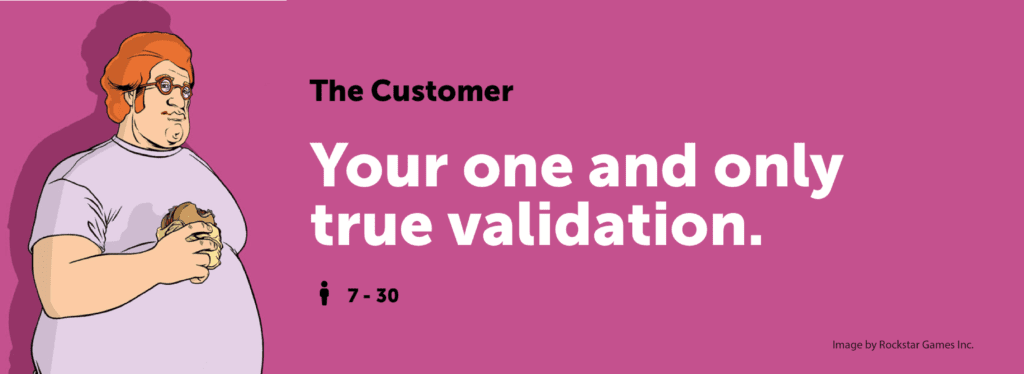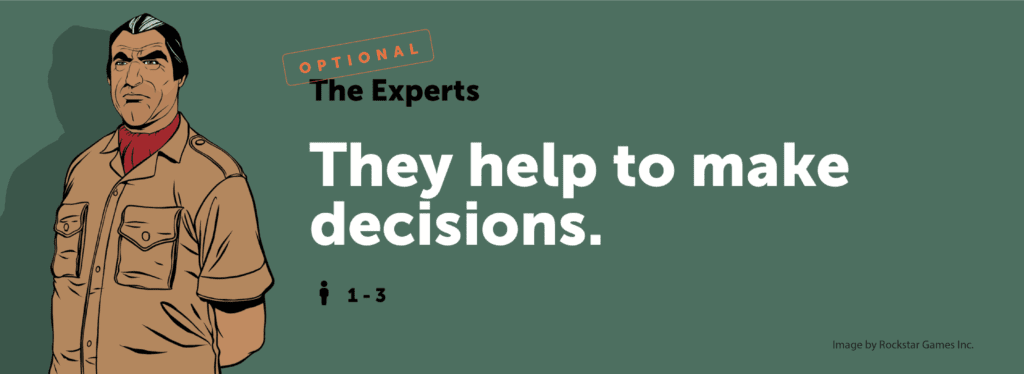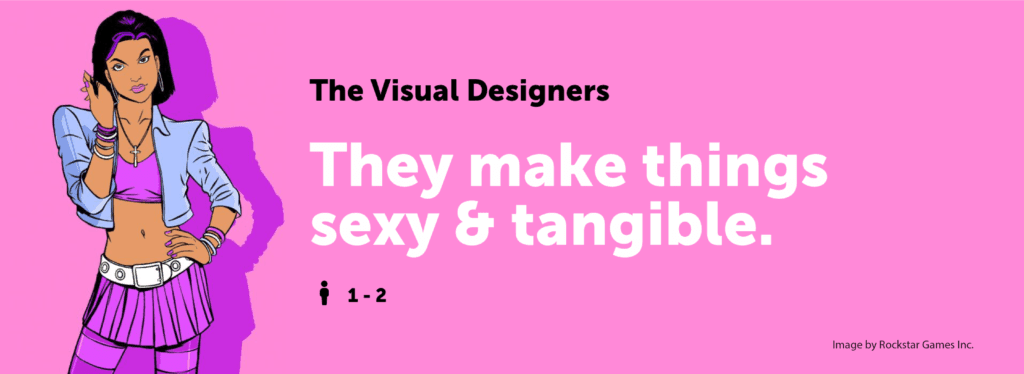Key takeaways
It’s essential, right from the start of an ideation sprint, to get aligned on the team you’ll be working with and their roles in the process.
Why?
Because in a design sprint you go from scratch to a couple of concepts in a very short period of time, with a small number of dedicated people. Which sounds great, but has one big danger: a wrong approach, or the wrong team, can make you go off-track in no time, resulting in unsuccessful outcomes. And since an ideation sprint revolves all around the people, you better have the right ones on board.
No customer validation and you drive into a destination without a real need. No market experts and you end up by chasing an oasis that might be just a mirage. The wrong set of people and you risk being all by yourself in the desert of your company, with no one to support your vision nor fund it.
Here’s the line-up of the usual suspects in an ideation sprint, how to spot them, and how to work together with them.

Role
- Mostly involved before or after the sprint week
- Input used for need detection upfront or concept validation afterward
- Qualitative interviews are the preferred technique on early-stage idea sprints
- Joins in during validation stage
- 7 to 30 people
So you’ve been hanging around with a bunch of people in one room, thinking of all possible ways to disrupt the market by coming up with “the next big thing”. But there’s a big danger if you don’t validate it with a potential customer.
Customers are special types of beings. They don’t know exactly what they want but are very good at telling you what they don’t like about your product.
This character is mostly involved before or after a sprint, but not in the process of generating ideas. Before the sprint, their input can be used to identify market needs, a great kickstarter for your ideation session.
It’s difficult to ask potential customers about what new service or product they would like, especially if you’re focusing on disruptive changes versus incremental changes (e.g. a customer won’t easily tell you they need a service like Uber if it doesn’t exist yet). Instead, confront them with possible solutions. This will help them tell you what they like or don’t like about those solutions, so you can pivot your value proposition towards this feedback.
Tip: The customer’s voice is holy, but beware of bias. Don’t oversell your ideas and then ask for an opinion, but try to get an honest review from your customer. Make in-depth interviews as objective as possible, or you might get biased feedback, resulting in unsuccessful results afterward.

Role
- Design sprint program leader & SPOC
- Guru of the tools and methodology used during the sprints
- Can participate in sprint if necessary
- Full commitment from the start till the end
- 1 person
This one carries an important role because he (or she) holds the full track in their hands.
A facilitator should have previous experience running sprints. Because every track is different, they need to know exactly which methodology to use during the specific project. Knowledge of which tools are used, to reach certain outcomes in the ideation sprint is also crucial. Same goes for the ability to manage the different stakeholders during the sprint.
An ideation sprint is an unpredictable ride, so the ability to improvise and come up with inventive solutions right on the spot is a “must”.
The facilitator participates in the sprint only if necessary. It’s quite difficult to be creative and hold the sprint leading role at the same time.
Tip: Find a good balance between a structured process and the necessary improvisation that makes each track unique and tailored to the right outcome. In the end, the stakeholders in different sprints are never the same, and different techniques are needed to lead the team towards the defined North Star.

Role
- A mix of competences
- A healthy balance of outside in and inside out perspectives
- Full dedication during sprint week
- 2 to 4 people
The sprinters aren’t necessarily creatives. Ideally, you’d have a mix of competencies from within the company. The best way to shape this dream team is to involve a representative from every department relevant to the new startup you’re building. Et voila! You have all the knowledge of the company, concentrated in one small group.
There should also be a healthy balance between people from within the company and those who come from the outside, from an external party such as a venture building firm. This helps stretching the team’s mindset, bringing a fresh breath of innovation into the company walls, and working together as an agile team.
Tip: Some of the profiles we see the most, coming from within the company, are: marketing, product, technical, and salespeople. From outside of the company, we recommend working with experienced venture builders and relevant industry experts (about whom we’ll talk further on), who join as external members.

Role
- Higher level corporate management
- Help align the generated concepts with higher company goals
- Hop in as fly-in experts on key decision moments
- 2 to 4 people
This is a group of people that come from the corporate management, who joins in the final stage of a sprint. They don’t participate in the full track and there are very clear reasons why. First of all, they have a limited amount of time. Secondly, by being so focused on the company targets, they have a hard time being creative and thinking outside the box.
Nevertheless, they have crucial knowledge about customers, market, competitors, resources, etc. They can easily give feedback on which ideas will work or not, and what fits within the company DNA and what doesn’t. No wonder they play a key role in decision making!
Tip: Involve this stakeholder on key moments during the whole process to create buy-in and to stay on track with the company goals. Fly-in moments are great ways to include them, when it’s all about making decisions and not about generating ideas.
By taking part in the process and having a chance to give input, they are more likely to be on board with the final outcome.

Role
- Can be industry experts, technology experts, customer experts, etc.
- Can come from within the company itself, or be external advisors
- Hop in as fly-in experts on key decision moments
- 1 to 3 people
The experts come into the picture to help you make the right decision. Let’s say, an automotive company wants to create a corporate venture in the entertainment sector. But no one from the company actually knows anything about this industry.
This is the exact moment the voice of the management slightly fades away. They most likely have no knowledge in the new market. Experts, on the other hand, can provide invaluable insights.
An expert doesn’t always have to be someone from outside the company. There can be a specific person within the corporate walls who’s expertise lays within the area of your new startup idea. They can join the sprint together with the management to help make the decision.
Tip: Once you have decided which markets and technologies you want to step into, get in touch with the experts. With the right people on board you will have all the valuable industry, market, and trends insights you need to start a successful new venture.
The experts should be chosen and invited ASAP, to avoid the possibility of their agendas being already booked.

Role
- A mix of UI/UX design and development skills
- Focus on creating mock-ups of final concepts
- Full dedication in the last 2 days of the design sprint
- 1 to 2 people
Create as many great concepts as you want to and hang them all over the room, but no one will ever get “hungry” from unreadable scribbles and shaky doodles.
To convince the decision makers, concepts have to be tangible. Usually, the best solution is to create a realistic mock-up.
The designers are usually involved after the first 2 days of the creation process. When the final concepts start to form, they start working in parallel with the sprinters, bringing ideas to life in the second part of the sprint.
Tip:
Find people who are comfortable designing and creating mock-ups fast, and have the capability to design ‘quick-and-dirty’ from a very draft concept. Mock-ups need to be tangible for feedback, not a final design. And don’t forget that there are always strict deadlines, which they have to be able to keep up with.
It’s not rocket science, it’s not some guru methodology. But if not applied properly, the consequences of starting off with the wrong set of people are grim. Who you put into your design sprint has a crucial impact on the outcome.
Yet again, a design sprint is all about the people. So only the right people management will lead you to the desired results.
Are you looking for ways to take your business strategy to the next level?
Tell us all about it! Corporate innovation is our specialty!








